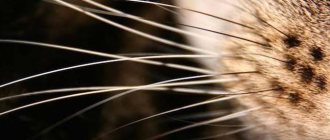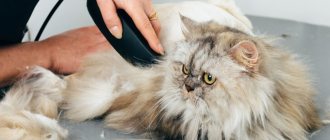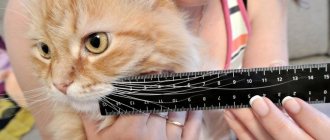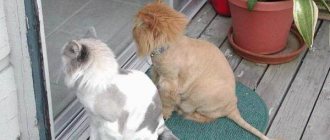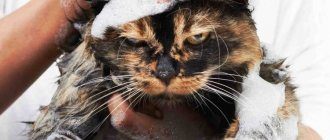Quick answer: 24 . Today we will find out how many whiskers cats have , as well as their full purpose. Cats are charming, graceful creatures, but few people have really thought about why their pet needs funny whiskers (whiskers).
But they not only decorate the pet’s already cute face, but also perform a number of quite important functions.
They are responsible for the animal’s sense of smell and its orientation in the surrounding space. By vibrating their whisker hairs, cats learn about their environment and the objects in it, so their presence and healthy condition play a very important role.
How many whiskers do cats have, their length and functionality?
Quick answer: 24 . Today we will find out how many whiskers cats have , as well as their full purpose.
Cats are charming, graceful creatures, but few people have really thought about why their pet needs funny whiskers (whiskers). But they not only decorate the pet’s already cute face, but also perform a number of quite important functions.
They are responsible for the animal’s sense of smell and its orientation in the surrounding space. By vibrating their whisker hairs, cats learn about their environment and the objects in it, so their presence and healthy condition play a very important role.
How many whiskers do cats and cats have - varieties
Cats typically have about 24 whiskers on their faces, 12 on each side, in a horizontal pattern of four rows.
In addition to the nasal area, hairs are also observed on the animal's chin, above the eyes, in the tail area and on the inner pads of the front legs.
It is these hairs, excluding those on the nasal area (vibrissae - we will discuss this name later in this article) that are several times thinner than ordinary antennae, but they are also responsible for certain functions, transmitting information to the pet about the current situation around.
At the same time, these hairs are several times thicker and coarser than ordinary wool, and the depth of their roots is 3 or even 4 times greater.
The type of bristles located on both sides in the area of the nose above the upper lip of the animal (as children drew in their drawings in childhood) are considered the hardest, thickest and longest.
Due to their mega-sensitivity, the cat processes a colossal amount of information, and the loss of these particular formations can lead to partial disorientation of the animal.
Short tail
It is noteworthy that the presence of a tail in a “rudimentary” state or its complete absence in cats is a sign of “noble” origin (in contrast to the same domestic dogs, whose tails are docked deliberately - to fit the animals to the standards of a particular breed). It is worth noting that there are only a few types of short-tailed/“tailless” cat breeds, which include:
Kurilian Bobtail
a short curved tail approximately 5-9 cm long, resembling a fluffy pom-pom and characterized by mobility, a relatively small body with strong bones, developed muscles and limbs of medium length, a triangle-shaped head with medium-sized eyes corresponding to the color, short-haired or semi-long-haired, but in in any case, with a fluffy collar on the neck and chest.
more details
American Bobtail
a short and flexible tail from 2.5 to 8 cm long (it can be straight, curved, and slightly curled at the end), a body of medium length with an athletic build and strong paws proportional to it, a round muzzle with strong jaws and ears, an internal the surface of which is covered with long fluffy hairs, short or long hair, but always thick and slightly harsh.
more details
Japanese Bobtail
a short tail no more than 12 cm long (straight, curled, curved or in the form of a pompom), a long and lean body with a flat back and slender legs (the hind legs are noticeably longer than the front ones), a muzzle with large oval-shaped eyes and large, wide-set ears, soft and silky coat of medium length.
more details
Mekong Bobtail
a short and broken tail with a length of at least three vertebrae (but no more than a quarter of the length of the body itself), a strong and muscular body of medium size with long legs, a wedge-shaped head with medium-sized ears (with rounded tips) and slightly slanted eyes, always bright blue , short silky coat with minimal undercoat.
Karelian Bobtail
a short tail 4-13 cm long (can be either kinked or almost straight), a strong body with an even posture and proportional paws, a narrow head with a small strong chin and rather large ears with tiny “tassels”, short or long hair ( necessarily dense).
Kurilian Bobtail
“no, not a relative”
short tail 3-8 cm long (with pronounced kinks), strong build with a slightly arched back and powerful paws, large trapezoidal head with a powerful chin and proportional ears, short or long hair (very soft to the touch).
more details
Pixiebob
short straight (but possible kinks) tail about 5 cm long, large and muscular body build with powerful bones and a clearly defined arch on the back, large pear-shaped head, tightly knit and strong paws (the hind legs are noticeably longer than the front ones), short or moderately long hair with different color options, but always with small or medium spots throughout the body.
more details
Manx cat
they may either have no tail completely, or have a small “stump” hidden under the fur, or generally have a tail of normal length, a medium-sized round body with a round head, powerful limbs with well-developed muscles (the front ones are noticeably shorter than the back ones), round eyes with a slight slant, short and thick coat, like “plush”.
more details
Cymric cat
Kymrik
tailless breed (but there can be either a “stump” or even a full tail), a tightly built physique with a wide chest and an arched back, short front and long hind limbs (with heavy shins), thick hair of medium length.
more details
What do cat whiskers look like and why are they needed?
A cat's whiskers are hard and fairly thick hairs, which are located several times deeper than the rest of the fur, as we found out earlier.
Scientifically, such whiskers are called vibrissae , which comes from the word to vibrate. The antennae grow individually and are enveloped in a constellation of nerve endings that have direct contact with the animal’s brain.
Each of them is individually responsible for a specific part of the cerebral cortex. Any damage or loss of one of them will cause slight disorientation subsequently of the type of functioning for which it is responsible.
Also, in addition to perceiving their surroundings, cats can express their emotions thanks to these hair formations. For example, if the antennae point down puzzled or sick about something
Another thing is when he rubs his hairs on your leg, this is regarded as a manifestation of love and tenderness for you.
In addition, there is an interesting fact when an adult cat often deliberately bites off the edges of the antennae of her kittens so that they do not run away as they grow up.
Norms for loss
Most often, antennae fall out not due to any abnormalities in the body. Adequate reasons could be:
- Change of antennae. They also cannot last forever and gradually wear out. Therefore, this is a natural change of vibrissae. If the above symptoms are not present, then there should be no cause for concern either. New ones will definitely grow in place of the old antennae.
- During a game or fight. You may not notice how during a super active game, embarrassment occurs and the mustache can easily get lost. And in a fight, the cat will not spare the opponent, so the loss of whiskers is a normal reaction here too.
- Fire. Many people have cats who curiously look at the fire near the stove or at a campfire in nature. Due to burning, the tendril will fall off over time.
By the way, there have been cases when the mother cat herself chewed off the children’s whiskers so that they would not misbehave.
How long are cat whiskers?
Now we know how many whiskers cats have , and now we know their length. As a rule, the length of hair formations in domestic felines is about 7 cm . But there are some exceptions, for example, the carriers of the longest antennae are individuals of the Maine Coon breed.
But sphinxes have much shorter hair lengths, and their shape is slightly curled. It is not uncommon for representatives of this breed to experience a complete absence of antennae, and this is not at all associated with any disorders in the body.
The length of a cat's whiskers directly depends on his diet and breed. And people believe that the longer the whiskers, the more productive the cat is at catching mice. It is a known fact that the length of a hair is equal to the width of the body of a furry animal.
Approaching a narrow passage, the cat, having this information, tries on whether it can pass through this hole or not.
Treatment methods
If a pet very rarely eats meat products, then its body lacks taurine and collagen. To correct the situation, it is necessary to include a vitamin and mineral complex in the diet. It should be remembered that vibrissae breakdown is a symptom, and not the disease itself, therefore, in order to prescribe effective treatment, a competent assessment of the state of health by a specialist is required. If whisker breakage is detected, you should not carry out any manipulations directly with the whiskers. They should not be smeared or combed. To fix the brittleness problem, you just need to find the cause and fix it. A qualified veterinarian will help with this. And the owner’s tasks include following the doctor’s recommendations, properly feeding the pet and caring attitude.
Why cats' whiskers fall out and how dangerous it is
Some agree with the opinion that if a cat has lost its whiskers, they are unlikely to grow back and the animal will die.
But the constant change of whiskers among felines is a completely natural and safe .
The whiskers will grow back just as easily as the fur after another molt. But if a very rapid loss and long-term lack of growth of whiskers is noticed, then you should definitely show your pet to a veterinarian.
This could be a simple lack of vitamins, or something more serious, so it is better not to ignore this fact and seek help from a specialist.
If a cat's whiskers are temporarily absent, you should not let your pet outside, as during this period the animal is susceptible to disorientation.
Without antennae, your cat feels completely insecure in space, since its “navigation system” is disrupted and it can simply get hurt, get stuck somewhere in a crevice, fall out of a tree, or get hit by a car.
This state can be compared to the sensations of a person who has lost his glasses. It is better to take care during this period and watch your pet at home, excluding any danger to her.
How many whiskers does a cat have?
Cats are quite graceful and perfect creatures. Is it possible to imagine the face of a homely beauty without funny and long mustaches, which not only decorate and give importance, but also perform a rather important function: they help to navigate in space. In science, whiskers are called vibrissae, from the word to vibrate. The cat, vibrating its antennae, learns about the object and surroundings. People living next to these charming creatures are well aware of the functions of their pets' whiskers, but few people have thought about how many whiskers a cat has.
Types of mustaches
In addition to the whiskers located on the cat's muzzle, there are other hairs that have a similar structure and function to those of regular whiskers, but are coarser than the animal's normal fur. These are hairs found on the cat's paw pads, above the pet's eyes, which look like eyebrows, under the chin, near the eyelids, and even on the tail. Of course, these hairs are less sensitive than the antennae located on the animal's face, but they are also important for hunting and orientation in space.
Where are they located?
One type of whiskers in cats is located on the sides of the nose above the pet’s upper lip, as children draw in pictures. It is these whiskers that are the longest and toughest; thanks to their sensitivity, they help the cat process a huge amount of information. Thickened hairs located on the cheeks, chin, and above the eyes are also vibrissae. Surprisingly, the compacted hairs located on the ankles of the paws and between the toes are also considered vibrissae.
Further care for the animal if its whiskers have been cut off
Do lost whiskers grow back in cats: even after trimming the hairs on the eyebrows and chin, they will be restored in 14-21 days. There are no special means to accelerate their growth - doctors advise using multivitamin complexes specifically designed for animals. They allow hairs to grow faster and become thicker.
Natural recovery will occur provided that no damage to the hair follicle occurred at the time of loss of the mustache. Animal care includes:
- protecting it from hot objects: fireplaces, gas and electric stoves, candles;
- using a special cap will help reduce the risk of head injuries;
- if a pet is placed in a cage for a while, then it will not be able to accidentally harm itself;
- an injured animal should not be allowed out into the street - there it can get under the wheels of a car, fall from a height, crash and damage not only its paws, but also its head.
Each new haircut of the whiskers will cause aggression in the pet towards its tormentor. If there are children in the house, then they immediately need to be explained why there are hard hairs on the cat’s body and what the risk of losing them is.
Trimming whiskers will not make a cat look beautiful; they play a big role in choosing a partner and communicating with familiar and unfamiliar relatives. Having lost their sixth sense organ, animals cannot hunt or move through previously unexplored places. Nature has protected furry pets, but it will take a long time to recover from the loss, during which time they can suffer seriously. Any stressful situation does not pass without a trace, then you should not be surprised at an animal that is aggressively opposed to its own owners.
Why does a cat need a mustache? This question can be asked by a child to his parents or by people who have taken a furry animal into their home for the first time and would like to find out themselves. It would seem that whiskers are longer hairs on the animal’s face. However, everything is not as simple as it seems.
How many whiskers does a cat have?
Normally, a cat has 24 antennae. They are arranged in four rows on each side. Moreover, the two upper rows of whiskers can move autonomously, regardless of the two lower rows of whiskers.
There are three vibrissae in each row, that is, there are 12 antennae on each side of the muzzle. In total, these cute creatures have 24 vibrissae, without which they could not even exist. This refers to the antennae growing on the upper lip, in zoology called the anus, which is adjacent to the nasal mirror. If you count the total number of antennae on a cat, then on the face, together with the vibrissae located on the whiskers, eyelids and chin, there are from 33 to 40 antennae.
What is the length
Typically, the length of a cat's whiskers varies from 5 to 7 centimeters. But there are also exceptions. For example, cats - representatives of the Maine Coon breed - have registered truly gigantic whiskers - 19 centimeters, and in the Cornish Rex and Sphynx breeds the whiskers are not only small in size, but they are also curled, thereby making the whiskers look even shorter than they actually are . There have been cases when sphinxes had no mustaches at all, and this did not in any way affect their ability to navigate in space.
There is a popular belief that in a cat the very tips of the splayed whiskers are equal to the width of the animal. This helps them navigate when passing through a narrow opening. Having fluffed its antennae, the cat knows in advance whether it will fit into a given hole or not. As soon as he touches the hole with the tips of his mustache, he has reliable information about whether he should stick his nose in there.
The distance between the tips of the whiskers in a cat corresponds to the width at the shoulders of this animal.
A cat's whiskers are not only an attribute of beauty, but also a rather important organ. An experienced owner will determine not only the physical, but also the psychological state of the pet based on the condition of the mustache. And, if at some point the number of antennae on a cat decreases, then this is not a problem, the main thing is that you need to pay attention to your pet. With the necessary care, the broken antennae will grow back and perform their function properly.
Source of the article: https://veterinargid.ru/cats/interesnoe/skolko-u-koshek-usov.html
What happens if you trim your mustache
The consequences of losses are difficult to predict; they are varied and depend on individual characteristics, whether the cat is a street or domestic cat.
What happens if you cut off a cat's whiskers?
- Pets will begin to look for secluded places and be reluctant to communicate with the owner.
- Street - will have problems finding food, will begin to miss the victim more often, remain hungry until the whiskers manage to grow back.
Navigation disorders are the answer to the question of what will happen if cats' whiskers are trimmed. For some time, the animal will lose the ability to easily navigate the space around it.
- inability to walk in a straight line;
- frequent falls;
- collision with furniture;
- various injuries.
Failure in behavior is associated with the absence of habitual signals about obstacles and health hazards. Such deviations are not typical for everyone. In most cases, the problem manifests itself as difficulty in jumping, free orientation in the dark, or in unfamiliar surroundings.
Vibrissae help cats maintain perfect balance
Experienced breeders report the following deviations in the behavior of young animals and adult pets, which will happen if you cut off a cat’s whiskers:
- inappropriate behavior based on stress and fearfulness;
- lack of contact, withdrawal into oneself;
- lack of physical activity;
- increasing the amount of sleep.
Important! Comfortable conditions for a cat that has lost its whiskers will provide an opportunity to reduce the risk of injury, but will not ensure its peace of mind
Will they grow back?
During scientific research, parts of the test animals had their whiskers removed completely or partially. Behavioral studies have shown that pets are more likely to get stuck in narrow holes, miss them, and be unable to get into them. Such failures had a bad effect on the psyche, the cats began to be afraid and hide, giving up any attempts.
You should not conduct your own experiments on a cat and trim its whiskers. It will take her a long time to grow them, and all household members will have to endure outbursts of aggression and other unpleasant reactions from a mentally unstable psyche.
Inappropriate behavior is the result of loss of vibrissae
Do cats grow whiskers?
Recovery will take some time. Their growth rate is three times faster than fur regrowth. Despite this, veterinarians warn that cutting the whiskers means losing the organs of vision.
What is the correct name for a mustache and why?
A cat's whiskers give it a sense of space. They are detectors that provide information, for example, about changes in atmospheric pressure, so most folk signs are associated with the behavior of pets.
The scientific name for cat whiskers is vibrissae. The word comes from the Latin - vibro (vibrate, fluctuate). The mustache got its name due to the constant small tremors and vibrations. If you look closely at the cat's face, you will see that the whiskers are constantly quivering. Vibrissae are an organ of touch that allows animals to navigate in complete darkness. Vibrissae are located not only in the area of the upper lip and chin, but also under the eyes and on the paws.
Vibrissae are much thicker than normal hair. Each whisker has its own muscle fibers that are responsible for its movement. A nerve impulse departs from each vibrissae to the cerebral cortex, which allows the received information to be processed as accurately as possible. Each cat's whiskers are well supplied with blood and also have access to the trigeminal nerve.
The vibrissae are so sensitive that at the slightest movement of air, they send signals to the brain regarding the position of the body in space.
How can an owner harm a pet?
To understand how important whiskers are for a kitten, let's try to figure out why he needs them. Literally, vibrissae means “to vibrate.” If you take a closer look at the cat, you will notice that they vibrate from the objects that it touches.
Each antennae is an independent organ of touch that is connected to the brain. Vibrissae are located in the skin three times deeper than the bristles and are surrounded on all sides by nerves through which information is transmitted to the pet’s brain.
Each antenna transmits information to its corresponding area of the cerebral cortex
That is why it is necessary to pay special attention to the factor of loss of whiskers by the cat, since he is temporarily unprotected from the outside world
Cats' whiskers are also called "vibrissae"
For any cat, even an apartment cat, having healthy and strong whiskers is very important. However, modern pets often suffer from problems such as whiskers falling out and breaking off. What to do about it?
What to do about it?
We suggest you read: Diseases of the Rhodesian Ridgeback
How to help a cat?
A lack of minerals and vitamins can cause your kitten's whiskers to be short, broken, or missing altogether. Tiny kittens should be fed using natural food.
And in general, the issue of choosing food for a pet needs to be approached seriously and responsibly.
- The reason why a kitten's whiskers break is due to the developmental characteristics of the animal. Cats, like people, have a concept of adolescence. At this time, baby teeth fall out and hair grows. The mustache also falls out.
- If the problem is in the physiological characteristics of your pet’s maturation, you can help his body get stronger quickly with the help of calcium, omega-3 fatty acids and vitamins. However, you should not choose the drugs and dosage yourself, otherwise you can harm the cat even more.
- Only a veterinarian can give qualified advice on this issue.
- Sometimes the vibrissae break off due to some kind of fungal infection, in which case you should definitely consult a doctor.
It happens that the whiskers become damaged while playing with other pets or children. It is necessary to monitor the child’s behavior and not allow him to abuse the animal.
With the help of whiskers, cats better navigate in space and move in the dark. Therefore, you need to do everything to ensure that the kitten recovers.
The purchased food may not meet the requirements, so your pet will need to take vitamin and mineral complexes.
Very often the owner himself is the cause of the animal’s poor health. He provokes this by performing the following actions:
- Mustache plucking.
- Shortening of the vibrissae.
- Trimming your mustache to make it grow faster and thicker.
Such actions can damage the animal's mental state. The cat will have difficulty oriented in space, sleep restlessly, limp, and experience discomfort. A cat's whiskers are removed only if prescribed by a veterinarian. A common reason that forces the use of this measure is ingrown mustaches into the skin or fungal infections.
Having noticed a similar problem, every inexperienced owner wonders why the cat’s whiskers are falling out, what to do and how to help her. When hair loss is rare and temporary, there is nothing to worry about. Frequent and abundant loss and fragility of the whiskers is a reason for an early visit to the veterinarian.
Ignoring the problem can lead to serious complications during the development of certain diseases. Therefore, after making an accurate diagnosis, treatment should be started immediately in order to save your pet not only and not so much from whisker loss - sometimes even from death.
If during the examination and conversation it is revealed that the cause of the loss of whiskers was an incorrect feeding system, a veterinarian will help you adjust a new balanced diet.
Features of the structure of whiskers in cats and cats
Cat whiskers are different in structure from fur hairs. The base of the vibrissa is long and rigid, but at the same time has high elasticity. The vibrissa follicle is located in the upper layers of the skin, actively supplied with blood.
The root of the mustache is located in a special sac, which is surrounded by receptors and a large number of nerve endings. This allows you to capture even the smallest air movements.
Each whisker is located in a specific place, because striated muscles are responsible for the movements of the cat’s whiskers. External information that enters through the vibrissae is converted into nerve impulses, travels along the trigeminal nerve and enters the brain. There it is processed, and the cat gets a picture of what is happening in several dimensions.
In kittens that develop in the womb, the first hairs to appear are the vibrissae. Therefore, it is almost impossible to sneak up on a cat unnoticed, even in the dark. The only way to catch a cat by surprise is if the enemy approaches from a downwind area.
A healthy cat has 24 vibrissae on its face, as well as 12 on each side in 4 rows. The lack of these important tactile detectors indicates possible problems in the health of your pet.
Locations
Everyone has seen long, thick hairs on the cat’s face, but the whiskers are not only located here. They are:
- around the nose;
- on the lip pads;
- above the eyes, where the eyebrows are;
- on the lower jaw, on the chin.
In addition, there are vibrissae even on the front legs. Of course, they are not that noticeable.
Length
The whiskers located on the muzzle are on average 5–7 cm in length. Depending on the breed of the cat, the whiskers may differ. Maine Coons have the longest whiskers. And in sphinxes, on the contrary, the vibrissae are very short, and often also curled.
The length of the whiskers is greatly influenced by the cat's nutrition; when it is complete, then her whiskers are truly luxurious.
Thickness
The thickness of the whiskers differs depending on the sex of the animal: cats have thicker whiskers than cats. Depending on the location, the thickness also varies. On the cheeks the whiskers are much thicker than above the eyes, and on the front legs the whiskers are only slightly thicker than the rest of the animal's hair.
The thickness of the vibrissae is explained by the fact that the place where each hair grows is rich in nerve endings. And their number is quite large, you can even notice that there is a tubercle at the base of the vibrissae.
From the mustache straight to the brain: how do they work?
It is interesting that the information that comes from the sensitive mustache and from the eyes goes through one channel - the ternary nerve.
This allows the brain to summarize signals, process them and create a three-dimensional picture of the world around us. Depending on the lighting, the pupil tends to expand or contract. In complete darkness, it is maximally expanded, meaning it has difficulty focusing on nearby objects. The mechanoreceptors, which are located at the base of the mustache, do not need light; they only pick up the vibration of the hair from air currents. This allows you to determine the location and distance to an object and avoid obstacles in time, even in complete darkness.
The very first hairs that kittens develop in the womb are vibrissae.
As we know from school physics courses, air not only never stands still, but also changes its direction when colliding with an object. Sensitive vibrissae are capable of recreating a clear picture of the surrounding environment based on air movement data. For this reason, it is impossible to approach a cat unnoticed.
She may not see or hear you, but she catches the reflected air flow. The only way to catch the animal by surprise is to approach from downwind.
Vibrissae in cats in the wild
By nature, a cat is, first of all, an excellent hunter; as they say, it’s in her blood. And here the mustache plays an important role. Thanks to them, a cat can close its eyes at the right moment to protect them from a branch or blade of grass while making its way through thickets and bushes. And then continue the hunt without taking your eyes off the victim. When prey is caught, the predator holds it in its teeth out of sight. At this moment, only the outstretched mustache helps to assess the situation and control the victim’s behavior.
Confident cat jumps are accomplished solely thanks to the vibrissae. By moving them, the cat determines the direction and speed of the wind, this allows it to adjust the force of the push and the position of the body in the jump.
Worn out or broken vibrissae are restored regardless of molting. This once again emphasizes their incredibly important role in a cat’s life.
Particularly long and coarser hairs can be seen throughout the coat. They are much softer and do not play such a significant role as a mustache, but they also have some sensitivity. These hairs help the cat determine the nature of touches and distinguish between dangerous and pleasant contacts.
When meeting a cat, you can easily determine its attitude towards you. Interest, curiosity and friendliness if the mustache is directed forward. But if the animal presses them to its muzzle, then it is better to hold off on stroking, the cat is aggressive. The movement and location of the whiskers is a kind of “gesture language” of these animals.
What functions do whiskers perform in cats?
Next, let’s find out why a cat needs a mustache. The main vibrissae on the muzzle and additional ones in other places have the following functions:
- The cat navigates in space by air movements. She evaluates the appearance and size of surrounding objects, the distance to them, and whether the parameters of the holes she wants to crawl through correspond to the size of her body. Mustaches help especially well in the dark. Cats, of course, see better without light than people, but still not well enough for full-fledged hunting or active pastime.
Vibrissae are responsible for important moments in a cat’s life.
- A cat needs whiskers for hunting. With the help of its whiskers, it evaluates the direction and strength of the wind for jumping, climbs trees, and also controls the behavior of the caught prey, which the cat carries in its teeth.
- Thanks to its whiskers, a cat can express its emotions and mood. In a cat ready for action, the whiskers are widely spaced and slightly tilted forward, while in a frightened or angry cat, they are pressed tightly to the muzzle.
Why is it forbidden to cut your mustache?
A cat's whiskers are an incredibly important part of their navigation system. If the mustache is damaged, orientation difficulties will arise. A cat with a trimmed mustache may bump into objects at first, and when jumping, it may even fall and get injured. Also, the animal may get stuck trying to crawl into a hole that is too narrow.
You can’t trim a cat’s whiskers yourself, just out of curiosity. If damage to the whiskers occurred through no fault of the owner or household members, it is recommended to keep the pet at home for some time. This will reduce the risk of serious injury.
Cats often chew off the whiskers of their newborn kittens themselves. It is believed that the mother does this for safety reasons, to control overly curious kids. When the whiskers grow back, after 2-3 months, the kittens are already quite strong and are able to explore the world around them without running the risk of getting injured in places that are dangerous for completely helpless babies.
There are also breeds of cats without whiskers, for example, hairless cats. They navigate in space no worse than their counterparts with vibrissae. This is due to the fact that during the process of evolution, the whiskers of such hairless cat breeds disappeared gradually, with the atrophy of the nerve fibers.
The mustache has its own lifespan. Over a certain period, they wear out, losing their natural elasticity and conductivity. Such vibrissae are gradually replaced by new ones. A cat's whisker that has fallen out has a rounded end - a thickening. While a broken or clipped vibrissa has a pointed tip.
It is important to carefully monitor the condition of not only the coat and skin, but also the condition of the pet’s whiskers. Thus, the cause of excessive mustache loss and breaking off can be both physiological and pathological reasons. Various bacterial and fungal infections, as well as injuries, must be treated promptly to avoid complications.
Prevention of vibrissae loss
To ensure that your cat always maintains its beautiful and healthy whiskers, you need to follow some simple rules:
the animal must be treated in a timely manner for worms and parasites using special means; feeding the pet must be carried out in accordance with the recommendations of veterinarians; it is necessary to pay attention to the signs that indicate an allergy and promptly eliminate the factors that cause it; you cannot neglect the schedule of scheduled vaccinations and skip them; it is necessary to visit a doctor at regular intervals;
You can’t trim an animal’s whiskers; you shouldn’t even just pull them. These actions cause discomfort and contribute to the loss of whiskers. To preserve the richness of your cat's whiskers, you should:
- Feed your cat high-quality food. Cheap food will not bring any benefit and will destroy the animal’s immune system.
- Include additional vitamin and mineral complexes in the diet if the cat is on a natural diet.
- Animals on a natural diet need additional vitamin and mineral complexes, but the drug itself must be prescribed by a veterinarian
- Monitor the amount of water consumed by a pet fed with dry food.
- Before offering your cat raw meat or fish, heat the food or freeze it for 2-3 days to avoid infection with parasites.
A cat's whiskers are a significant organ, and its condition must be monitored. If you follow the recommendations of specialists and avoid the causes that cause the loss of whiskers, your pet will lead a full life for many years.
Problems with whiskers in cats and kittens
The condition of a cat's whiskers is an important indicator of health. Therefore, it is necessary to monitor the condition of the vibrissae and take timely measures to eliminate all kinds of troubles that may affect them. The following problems are usually encountered:
- Fragility. It appears due to some deviations in the environment. For example, dry indoor air leads to hair drying out and breaking off. The lack of fresh water in a cat has the same effect on its whiskers. Frequent bathing also has a negative effect on the elasticity of the antennae. The problem is solved by normalizing humidity, having fresh water, and using high-quality hair care products.
- Dropping out. Losing a mustache is a more serious signal than breaking it off. A serious signal of health problems. Loss of whiskers often accompanies allergic reactions in cats. Allergies in a pet usually occur to food, most often to milk and fish. When faced with whisker loss, you should pay attention to your cat's diet. Vitamin deficiency also causes massive loss of mustaches. It occurs against the background of a monotonous diet, which causes a deficiency of important microelements and vitamins.
- Poor growth. Poor whisker growth depends primarily on the general condition of the cat. The quality of food, the presence of vitamins and microelements, good coat care - all this is directly related to the growth of not only the whiskers, but also the animal itself. Poor mustache growth can also be caused by endocrine problems and metabolic disorders. If improving the quality of keeping your cat does not lead to a positive result, you need to contact a specialist.
How to find out the age of a cat
A cat is considered to become an adult when it is one year old, although growth can continue up to 1.5 or even 2 years. Much depends on the constitution. Long-haired and large-sized breeds are characterized by slow development. The natural aging process begins already in the 2nd year of life, so it is simply impossible to calculate the exact age of the patient.
A young and healthy cat, more than a year old
Approximate is determined by a combination of three characteristic features:
- according to the condition of the teeth in the jaw cavity;
- by the quality of the fur;
- according to the activity of the ward and the condition of the bone skeleton.
The age of a cat is determined primarily by the condition of its teeth.
How to determine a cat's age by its teeth
It is not difficult. Throughout its life, the animal eats, and at the same time abrasion, discoloration and wear of the working surface of the fangs occurs. The science of felinology does just that. Knowing at what stage of life certain changes occur, you can determine the approximate age:
- at 2 years there are weak signs of wear on the central incisors and a barely noticeable yellowish coating. There are no changes on other teeth;
- at the age of 3-5 years, the wear of the upper central incisors is clearly noticeable. There are signs of wear on the fangs. Almost all teeth are covered with yellow plaque;
- at the age of 5-10 years, both the central and middle incisors on both sides are worn out. You can observe their loss and cracks. The yellow coating is pronounced, accompanied by the presence of stone;
- at 10-12 years old, loss of central incisors occurs more often, and a distinct yellow plaque and tartar cover all teeth;
- when the animal reaches the 15-year mark, all its incisors are missing and the molars are severely worn out. Very old cats don't even have fangs.
When determining the age of a cat based on its teeth, it is necessary to take into account living conditions and health status. Proper nutrition, containing the required amount of trace elements, minerals and vitamins, can slow down tooth loss.
How to determine the age of a cat by its fur
The fur of an adult cat is not such a clear indicator of age as teeth, but it also undergoes changes. If kittens and teenage cats have a very soft and fluffy coat, then in an adult cat (cat), especially one that is older, it changes dramatically.
- At the age of up to 5 years, cats have thick and smooth fur with a distinctive shine and a pronounced pattern (in variegated pets).
- After 5-6 years of age, dullness and density of the fur and coarsening of some villi are observed. In motley cats, the pattern loses its clear outline.
- At the turn of 6-7 years, individual villi become gray.
- Starting from 10-12 years, changes are striking: the undercoat falls out and is poorly restored, the shine completely disappears, the fur noticeably thins and becomes coarser, and bald patches often appear near the ears.
Condition of the skin of Sphynx cats
In Sphynx cats, signs of aging are best determined by the quality and wear of teeth, since poor skin condition is not always an indicator of old age. Most often due to improper care. Old cats (10-12 years old) experience roughening of the skin and baldness. Due to poor functioning of the sebaceous glands, ulcers appear. Thermoregulation is disrupted, and increased sensitivity to cold occurs. The skeleton changes, problems with hearing and smell arise. The average life expectancy of cats of this breed is 12-13 years.
How to determine age by activity and skeletal condition
Age-related changes are also reflected in the cat’s musculoskeletal system, which affects its activity. Using these criteria, it is impossible to determine the exact age, but you can find out whether the cat is young or old.
- Pets from 2 to 5 years old are very active, have beautiful muscle definition, and their movements are graceful and precise. Excellent and tireless hunters, they easily overtake their prey. They love to play and frolic.
- The first characteristic signs of skeletal aging begin to appear at 7-8 years of age. This is noticeable by the sagging of the spine. Protruding shoulder blades indicate thinness.
- Older cats 13-15 years old are characterized by sagging muscles, which affects their volume. They move little, preferring to lie down or sleep. Burdened with illnesses, they are indifferent to games and are strongly attached to their owners, because they really need their care.

